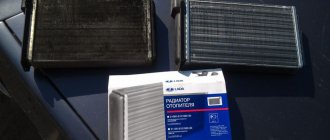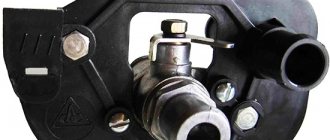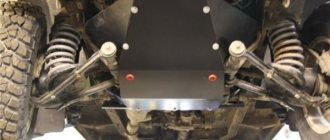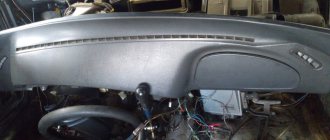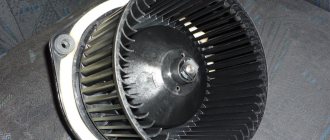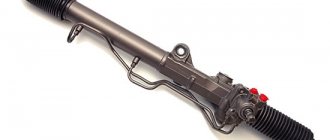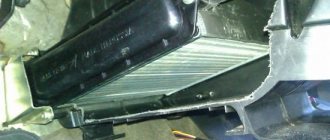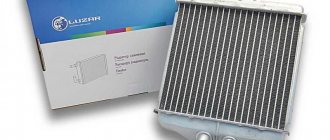I've seen a lot of how the stove tap is adjusted. So I finally did it myself. The procedure is very simple, and the effect is truly amazing. Yesterday I drove about 120 km, opened the windows several times. The only negative is that my panel got very hot. I think that in frosty weather the windows will thaw faster now.
On the driver's side, remove the panel cover. A little higher under the steering wheel, not immediately noticeable, the cable is attached to the heater tap. It needs to be shortened. I shortened it literally by 0.5 cm, making one more turn.
By pulling cable No. 20 (damper adjustment), I ensured that hot air entered all the side air ducts. After some time, having adjusted the length of cable No. 21 (adjusting the heater tap), I received hot air already at an engine temperature of up to 60 degrees.
Usually, newbies who have driven (or just started driving) a VAZ 2114 for the first winter season turn to car service centers with this question. The fact is that the car has such an unpleasant feature (here we say hello to the engineers of the Volga Automobile Plant), such as a problem with the operation of the stove. Moreover, for some it appeared in the very first winter after purchasing a new car at a car dealership.
Repair work
Knowing the structure of the stove, it is easy to repair. Before starting repairs, it is necessary to remove the wire from ground and drain the coolant.
Repair consists of the following steps:
- First you need to remove the instrument panel and carefully disconnect the air pipe through which air enters the cabin.
- Next, you should unscrew the two nuts from the shield that secure the faucet.
- Then you need to remove the seal from the tap pipes.
- Next, the nuts are unscrewed, with which the stove is attached to the body.
- Now you can remove the stove.
- Having completed the necessary repairs and adjustments, the heater is reinstalled in the reverse order.
Next, you should check the electrical system: resistor wires, electric motor, fan. In addition, you need to check the outlet and inlet hoses of the faucet.
After repairs, you should check the operation of the heating system. It should turn on as soon as the engine starts.
Heater repair at VAZ
Which heater tap is better?
Arriving at an auto parts store. On the shelf you will see 3 options for heater taps:
- Factory standard.
- Ball.
- Ceramic.
Let's figure out how they differ, and which stove faucet is better.
The first option is a standard factory one, which costs 80-100 rubles. Its operating principle is based on a rubber membrane. In practice, it is very unreliable, susceptible to acidification, and its installation is not recommended.
Moving on, the second option is a ball valve. The principle of its operation is based on a ball with holes instead of a rubber membrane, as in the first option. In fact, this specimen is also susceptible to oxidation, but it is much more reliable than a standard factory faucet.
The third option is a ceramic heater tap. The body of this faucet is ordinary plastic, but the shut-off element already consists of two ceramic shut-off plates.
Of all those listed, the ceramic faucet is the most reliable, and it is recommended to install only it. But it is worth noting that the coolant capacity of a ceramic faucet is less than that of a ball valve, therefore the heat transfer is also less. In other words, the most reliable faucet is a ceramic faucet, but it will heat less efficiently than a ball faucet.
Replacement instructions
The radiator is a replaceable unit, so if it is faulty, it needs to be replaced.
The replacement procedure consists of the following steps:
- First of all, you need to drain the coolant.
- Next you need to dismantle the dashboard. You can remove not the entire tidy, but only part of it to get to the radiator. How to remove the panel is described in the operating instructions.
- Before replacing, it is necessary to disconnect all wires and hoses that go to the radiator.
- Then you need to unscrew the fasteners and dismantle the unit.
- The removed radiator must be cleaned if it is clogged. If it leaks, it needs to be changed. Assembly should be carried out in the reverse order (video author - VChSLV).
After the repair, the microclimate in the cabin will be restored and no frost will be scary.
But first, check
However, before you start disassembling the stove and making technological changes to its operation, find out that other components of the system are working correctly. Improvements will not yield results if the problems lie elsewhere.
- Make sure the pump is working properly. Breaking off the impeller impairs heat transfer. If the car begins to overheat frequently in the summer, and the heater does not work well in winter, this may indicate this problem.
- Make sure the thermostat is working properly. If it is stuck closed, the stove does not heat up at all. Antifreeze does not go into a large circle. If it is stuck open, the car (and with it the stove) heats up very slowly, the air comes out only slightly warm.
- Make sure the stove fan is working. It should work in all speed modes.
- Make sure your cabin filter is not clogged. Where is it? This is probably your problem. Open the hood, you will find it in the part between the engine compartment and the passenger compartment, approximately in the center.
- Make sure your heater core is not clogged. It is recommended to wash it periodically (every 2-3 years) using special products.
Basic aspects of tuning
Car tuning is not only about illuminating the dashboard with LEDs. Tuning the VAZ 2114 stove is required in situations where cold air blows from the sides of the stove, or the interior is heated unevenly.
To do this, you need to remove the side cover on the gas pedal side. The clamps holding the throttle cable should be loosened. Then you need to pull it back and tighten the clamp. Next, you should install the damper control levers. From this moment on, warm side air should blow, warming the driver and passengers in the cabin.
Heating system repair
At the second stage of tuning, it is necessary to ensure that air coming from outside passes through the heater. The operation of the damper and the tap is carried out by the operation of one engine. It should be ensured that it does not control the damper. To do this, the right cover of the torpedo is removed, and then the one located on the right is disconnected and pulled from the two temperature control cables from the engine. The damper should be in its maximum position. The cable should be tightened and the excess should be trimmed.
Modification of the pipe is required if the air flow from the left deflector is too weak. It needs to be forcibly strengthened. To do this, you need to install a fan with a diameter of about 50 mm in the pipe. You can use a computer fan. First you need to remove the deflector. Then, having made a hole of the appropriate size, insert the cooler and seal it. Next, the pipe with the cooler needs to be returned to its place and the power supply restored.
You can connect the fan directly to the heater contacts. However, in this case, in order for it to work, you need to turn on the ignition.
If you properly modify the stove, it will work more efficiently. This will improve the comfortable conditions in the cabin of any car, both VAZ 2114 and UAZ. LED lighting will give the panel a beautiful appearance, especially at night.
Adjustment
Drivers solve this problem at the same time as replacing the radiator. to combine work. Or you can do without replacing the radiator if everything is fine with it. But it is imperative to check the screening devices for leaks. If the seal is broken, glue them with foam rubber or other insulation. Leaks will lead to cold air mixing with hot air, which will prevent the stove from working properly.
To adjust the device, you need to work on the faucet and the valve itself. It's better to start with the faucet.
- Remove the panel under which the device you need is located. It is not necessary to remove the dashboard, but for clarity it is possible. Plus, this will allow you to modify the cut-off device itself, glue it with foam rubber or other insulation. Basically you need a cable that responds to the cutoff. You will find it under the side dashboard cover near the gas pedal. On the body of the faucet itself there is a bracket that holds the cable sheath on itself. It needs to be removed.
- Remove the cable from the lever, after which you need to open the tap in the maximum open position.
- Now the cable can be disconnected from the lever block. You don't need the old cable, so throw it away. Close the faucet as needed.
- Adjust the length of the sheath and the cable itself. In this case, on the lever block, with the lever in the right position, the tap should be completely open.
- With the help of a latch, the cable is securely fixed in its place.
VAZ 2114 stove damper diagram
I've seen a lot of how the stove tap is adjusted. So I finally did it myself. The procedure is very simple, and the effect is truly amazing. Yesterday I drove about 120 km, opened the windows several times. The only negative is that my panel got very hot. I think that in frosty weather the windows will thaw faster now.
On the driver's side, remove the panel cover. A little higher under the steering wheel, not immediately noticeable, the cable is attached to the heater tap. It needs to be shortened. I shortened it literally by 0.5 cm, making one more turn.
By pulling cable No. 20 (damper adjustment), I ensured that hot air entered all the side air ducts. After some time, having adjusted the length of cable No. 21 (adjusting the heater tap), I received hot air already at an engine temperature of up to 60 degrees.
Hello everyone, having bought a car in winter, I noticed that hot air comes from the central air ducts, and cold air comes from the side ducts and onto the forehead. I decided to conquer this.
1. The easiest way: remove the left side cover of the torpedo, in the area of the gas pedal we see the damper rod cable and the cable fastening clamp, unfasten the clamp, pull the cable down, secure the clamp, set the heater flap control levers left - all the way to the right, right all the way to the left , turn the heater tap control lever all the way to the right and we feel that warm air is coming out of the side holes and onto the windshield.
2. What we did helps, but not 100%. It is now possible to regulate the temperature better, but within a small range. All the same, when the engine moves to the left, at some point cold air begins to blow from the side holes. This happens because this engine controls not only the heater valve, but at the same time also the damper, which allows access to outside cold air and it enters the cabin past the heater. To get rid of this, you need to disconnect the damper control cable from the engine. To do this: remove the right side cover of the torpedo in the area of the passenger's left leg, find the temperature control engine and see that two cables go to it. We disconnect the cable from the engine, which is located to the right in the direction of travel, stretch it so that the damper is in the position of the highest heating of the heater, bend it in the area where the cable is attached so that the damper always remains in the same position, bite it off, leaving about 1.5 cm so that the excess the length did not interfere with the movement of the engine. And, EVERYTHING! Now warm air blows into all openings, and the temperature is smoothly adjusted from maximum to minimum values.
I’m also attaching a video on an alternative solution to method 1!
The reasons for the malfunction of the stove on the VAZ 2114 can be very diverse. Almost every car enthusiast has problems with the VAZ 2114 stove, oddly enough, when cold weather approaches, the air temperature drops and the time spent warming up the car increases. Many car owners do not wait for problems to arise, but prepare their car for the winter in advance, in particular this applies to checking the working condition of the stove.
The second “jamb”: dampers
Another problem with the VAZ 2114 stove is the operation of the dampers. In the car, their position is regulated by three more cables. They also tend to become loose and malfunction over time. An indicator of a violation of their adjustment is the fact that hot air comes only from the central air duct, while cold air goes to the passenger seats and to the front window heater.
Adjustment of these cables is carried out similarly to the cable of the stove faucet. When the slider is moved to the extreme right, the dampers should be fully open.
If you plan to adjust the heater while replacing the radiator, you should also pay attention to the condition of the dampers themselves. If they are not airtight, they should be glued with foam rubber or any other insulation. Any leaks lead to the dilution of the hot air flow with cold air and, as a result, to a deterioration in the operation of the stove.
Modification of the left deflector
The left deflector (driver's) is located farthest from the hot air entry point. As a result, all losses affect him more than anything else. It also happens that there is warm air everywhere except it. Naturally, the driver will not like this much, especially if he usually drives alone in the car.
To improve the heating system and provide the driver's air duct with a sufficient flow of warm air, an additional fan is installed in it.
A computer processor cooling fan is ideal for this purpose (it can be bought at any computer store, it costs about 500 rubles). They come in different sizes and power, choose the right one based on the supply on the market. Or if there is an old computer somewhere in the garage, take it from there - it will do.
- Pull out the deflector.
- Prepare the wiring. If an additional pump is installed in the system, it is worth installing the power supply through the same switch. You can make a separate switch or, as a last resort, connect it from the ignition. It will turn on automatically when the engine starts.
- It is important to completely seal the remaining holes, otherwise the expected result will not be obtained.
Prepare a hole for installing the cooler.
By performing all these manipulations, you can achieve restoration or even significant improvement in the operation of the stove. If your work involves constantly moving around the city by car, these measures are simply mandatory.
Causes of malfunction of the VAZ 2114 stove
- The heater on a VAZ 2114 is leaking. In this situation, it is cheaper and easier to purchase a new radiator. Despite the fact that the hole may be small in size, the radiator will no longer be able to fully perform its functionality and fully comply with the presented characteristics. Of course, if you seek qualified help from a specialized service, the malfunction will certainly be eliminated, but this is not a solution to the problem, because a short period of time will pass and the defect will reappear, given that the amount of repair is not so small.
- The VAZ 2114 radiator is clogged. In this situation, there is a chance to give the radiator a new life if proper repairs are carried out. But before repairing it, it must be removed. Cleaning can be done using KARCHER or by blowing with compressed air. But this process must be carried out very carefully, because... The radiator may not withstand high pressure and will simply break as a result. And then you will definitely have to buy a new one to replace it.
- Motor failure. This problem occurs as a result of a damaged fuse. Solving this problem is quite easy; a failed fuse simply needs to be replaced. But perhaps this is not enough to solve this problem. The question arises, why did the fuse blow? Most likely, a short circuit has occurred in the wiring; to prevent a repeat situation, the best solution would be to “ring” the entire circuit to identify the system flaw and then eliminate it. Otherwise, if things go badly, a short circuit may occur, with negative consequences.
Tips for choosing a radiator
Let's look at the main nuances when choosing a stove for a VAZ 2114. As you know, the factory-produced VAZ 2114 heater device has a high level of required heat transfer. But the required model is simply not available for free sale; in this case, we purchase what is available. Naturally, the characteristics of a used radiator are absolutely no good, the reason is obvious, in a couple of months you will have to change the radiator again, in a word, you will be throwing money down the drain. In this situation, a better solution would be to overpay a little and purchase a new device.
Based on consumer reviews, radiators from the manufacturer DAAZ are in great demand, because The quality indicators of the produced models are met, the heat transfer parameters are also at their best. As for the material from which the VAZ 2114 stove is made, it is impossible to confidently determine the leader among aluminum or copper radiators. Each has advantageous indicators and certain disadvantages, such as heat transfer characteristics and operating life.
Air lock formation
On cars of the VAZ 2110 and VAZ 2114 models, an air lock often forms in the cooling system; it mainly occurs:
- due to loose connections in the pipes (for example, the clamps are loosely tightened);
- after replacing the coolant;
- if the cylinder head is broken.
The plug can be removed in several ways (provided that the head gasket is not broken), let's consider one of the options. To expel air from the cooling system, proceed as follows:
- put the car on a hill so that the engine is higher in level;
- unscrew the expansion tank cap;
- fill the tank with antifreeze to the maximum;
- we start the engine and warm it up to operating temperature, increase the speed to about 3000;
- Gently squeeze the lower radiator hose with your hand, it is important not to get burned while doing this, do not close the expansion tank cap;
- As air leaves the cooling system, the antifreeze will “sink” in the tank; it must be added regularly. As soon as bubbles stop appearing when you press the nozzle, hot air will begin to flow into the cabin when the heater is on.
VAZ 2114 stove diagram
The diagram clearly shows the structure of the VAZ 2114 stove:
number 44 is the ventilation motor, 45 is the additional resistance resistor, 46 is the toggle switch for switching speeds. This diagram makes it clear how the VAZ 2114 heater works.
VAZ 2114 stove diagram
To diagnose the performance of the VAZ stove, you must apply the following steps:
We turn on the VAZ 2114 heater with switch (1) to the 1st, then 2nd and 3rd speed modes. Lever (2) and (4) adjust the desired air direction, and the last one (4) has the function of selecting the air temperature. It also happens that even some people do not know how to turn on the heater on a VAZ 2114.
VAZ 2114 stove diagram
If there are no signs of operation, therefore, the fan does not turn on at all. But if the radiator shows signs of operation at some speeds, therefore, the reason is not a fan malfunction, but possibly a resistor (additional), or the VAZ 2114 interior heater does not respond to the switch. If the fan is running at full power and the temperature is set to the maximum when the engine is fully warmed up, and cold air comes from the air duct. This is likely the cause of a clogged heater radiator.
Reasons for decreased performance
Despite the simplicity of the design, problems with the VAZ-2114 stove often arise. They are mainly associated with a drop in the performance of the heating system - the stove heats the air poorly, blows cold or slightly warm air. In this case, the reasons for poor operation of the stove can be both general (warming up is weak at any control unit settings) and when operating in a certain mode, for example, at idle. Or, for example, cold air or slightly warm air blows only on the side windows, and in other modes the heating works normally.
Common reasons why the stove stops heating:
- the heater radiator is clogged or an air lock has formed in it;
- when switched to heating mode, the heater damper does not fit tightly to the body, which is why part of the air flow moves bypassing the radiator and enters the cabin cold;
- the tap does not open completely - this is one of the main reasons for a poorly heating stove;
- the formation of cracks at the joints of the housing and air ducts, which causes strong dispersion of the air flow.
It is not difficult to determine the cause of a general decrease in the efficiency of the heating system. To find out why the VAZ-2114 stove does not heat well, you need to remove the side decorative panels from the center console, and then warm up the engine and turn on the stove at maximum power. After this, we try the antifreeze supply pipe to the heater radiator up to the tap and behind it. The same heating temperature of the tube on both sides indicates that the tap is working properly and the problem lies in the radiator. If after the tap the pipe is less warmed up, the tap is jammed or does not open completely.
After this, we determine the temperature at the inlet and outlet pipes of the radiator. If the heat exchanger is not clogged and there is no plug in it, then the temperature of the outlet pipe will be lower than the inlet pipe. But if the outlet tube is cold, antifreeze does not circulate through the radiator, which indicates the formation of an air lock (airing) or clogging.
A common cause of failure of the VAZ-2114 stove is wear and play in the sliders. Because of this, even when they are moved to their extreme positions, the cables do not bring the valve and dampers to the stop (the valve remains closed, and the dampers do not block the air flow channels). This problem can be easily resolved - you need to make an adjustment and shorten the cables a little.
How to carry out work to replace the VAZ 2114 stove (radiator replacement)
The heating of the VAZ 2114 is replaced as follows, first you need to drain the cooling liquid from the system, only after this simple manipulation is the panel (instrument) removed in order to easily get to the radiator. To save operating time, it is possible to detach only part of the panel, in the area of the glove compartment and console. It is better to carry out this procedure together, so that one person pulls the panel as necessary, and the second removes the radiator. But there is another method: remove the panel fastenings from both sides, and then carry out the procedure of loosening the brackets. As a result, you can easily replace the VAZ 2114 stove with a new one. But do not forget to disconnect the wires first. The next step will be to remove the nuts that secure the radiator to the body, and further loosen the clamps that secure the pipes. That's all, further replacement is carried out in the reverse order.
Diagnosis of heating system faults
Heating system malfunctions are accompanied by the following symptoms:
- the fan does not work;
- cold air enters the cabin;
- the damper does not work;
- there is a coolant leak;
- the stove begins to make uncharacteristic sounds (whistles, hums, gurgles);
- Steam or smoke appears from the heater ducts.
Why the stove does not work or does not heat the air
If the stove fails, it either does not work at all, or it works but does not heat the air. In the first case, first check the fan wiring, starting with fuse F7. If the fuse is blown, replace it. Then they check the relay, which may not turn on the first time or only when the engine is warm. In this case, the relay is replaced with a new one.
Then the serviceability of the electric motor is assessed. To do this, power is directly supplied to its contacts from the battery. If the electric motor starts to operate at maximum speed, then it is in good condition. Otherwise, it will need to be repaired or replaced.
The intensity of the air flow is adjusted using a resistor having two spirals with resistances of 0.82 Ohm and 0.23 Ohm. In the first mode, the current flows through both spirals, in the second - only through a spiral with a resistance of 0.23 Ohms, in the third - bypassing the spirals, that is, without resistance at all. If the resistor is faulty, the fan will only operate in the third mode at maximum speed (handle in the extreme right position). The problem is solved by replacing the resistor, which is located on the driver's side above the accelerator pedal.
If the resistor is faulty, the heater fan will only be able to operate at maximum speed.
If cold air enters the cabin, this may be due to:
- Airlock. It could have formed when replacing the coolant, when the system was depressurized, or because there was insufficient amount of coolant in the system. To remove the plug, remove the heater radiator pipe, use a watering can to add antifreeze to the maximum and put the hose back in place. After starting the engine, coolant under pressure will displace the remaining air from the system.
- Stove tap jammed. This happens if the tap was not initially opened all the way, and during operation, oxide and scale formed on the inner surface, preventing the normal circulation of the liquid. You can try to open the tap using pliers or immediately replace it with a new one.
- The stove radiator is clogged. When using low-quality coolant, the radiator honeycombs may become clogged. The problem is solved by flushing or replacing the heat exchanger. The feasibility of washing is determined by the scale of contamination.
- Installation of a low-quality radiator. In a defective product, the honeycomb may be incorrectly soldered. The radiator should be replaced.
- Low pressure in the cooling system. If heat transfer increases at higher speeds, the pump needs to be replaced.
- Low coolant level. It is necessary to check the level and add antifreeze if necessary.
- Damage to the heater fan impeller. The impeller is carefully inspected and replaced if mechanical damage is detected.
- Cabin filter dirty. If it is heavily polluted, the power of the electric motor will not be enough to pump warm air into the cabin. The filter is replaced with a new one.
- Damage to the cylinder head gasket. If the cylinder head gasket is blown, white smoke will come out of the exhaust pipe. The problem is solved by replacing the gasket and dismantling the cylinder head.
This is interesting: Registration of a car with the traffic police
If the stove is clogged, warm air will stop flowing into the cabin.
Heater dampers don't work
The distribution of air flows throughout the cabin is carried out by dampers, which, in turn, are controlled using cables. When these cables fail, problems arise with directing the air flow to the windshield or to the foot area. In addition, the damper that blocks the flow of air from the street begins to work incorrectly. In this case, adjustment of the damper drives is required.
Such situations can arise even on a new car. Slightly warm air begins to flow from the lower, upper and side deflectors, and hot air begins to flow from the center console. This is due to the poor build quality. There are gaps between the joints of the air ducts and the dampers, which leads to warm air entering only from the center console and heating the panel from the inside.
The drive cable is always taut. Therefore, over time it bends, breaks off or stretches. In this case, it is necessary to adjust the damper drive, which is performed in the following order:
- In the stove, we look for a bracket with which the cable sheath is held on the heater body.
- A galvanized metal lever located on the left side is pulled back. This position corresponds to the maximum opening of the damper.
- The length of the cable is tightened and adjusted. The long lever on the lever block in the extreme right position should open the damper completely.
- After adjustment, the cable is securely fixed.
Video: adjusting the heater damper
Why is antifreeze leaking from the stove?
A coolant leak in the heating system can occur from:
- stove radiator;
- stove tap;
- stove pipes.
If a coolant leak occurs from the radiator, it is usually replaced with a new one. Repairs to restore tightness are usually complex and labor-intensive. In addition, if the radiator has been in use for a long time, its tubes become clogged with deposits and dirt, and, as a result, heat transfer decreases.
The valve opens and closes the coolant supply to the radiator, thereby regulating the heat in the cabin. Over time, it may begin to leak, as evidenced by the characteristic smell of antifreeze in the cabin, a puddle on the floor on the passenger side and a decrease in the coolant level in the expansion tank. The faucet cannot be repaired and in such cases is replaced entirely.
If the heater radiator starts to leak, it is usually replaced with a new one.
The cause of coolant leakage from the pipes is usually their wear - the rubber ages and cracks over time. When diagnosing a problem, you need to wipe the suspected leak areas with a rag and observe the outlet and inlet pipes on a warm engine. Worn hoses are always replaced with new ones.
The stove makes a hum, whistle, murmur
The cause of uncharacteristic sounds (whistle, hum, murmur, etc.) from the heater is usually a faulty electric motor. Lack of lubrication, contamination, wear of bearings and bushings - all this leads to the fact that the motor begins to whistle. It is removed, disassembled and cleaned, and the rubbing elements are lubricated. If the bearings are heavily worn, the motor will not make a whistle, but a hum. In such a situation, lubricant may not help, and the electric motor will need to be replaced.
Steam is coming from the stove
Sometimes steam starts coming out of the stove. The reason for this is a leak in the heater core. The leaking coolant hits the hot radiator housing and begins to quickly evaporate, and the smell of antifreeze appears in the cabin. To fix the problem, you will need to disassemble the stove and replace the heat exchanger.
Sometimes white steam comes from under the hood and enters the cabin. This happens when antifreeze gets on the hot manifold or exhaust system pants. In this case, you will need to find the location of the leak and fix it. The most common cause is damaged pipes.
This is interesting: Self-installation and configuration of the Starline alarm system
Repair of VAZ 2114 stove
To repair the stove, it is necessary to remove it and then make the necessary adjustments.
VAZ 2114 stove diagram
VAZ 2114 stove diagram
- Before removing the heater (1), be sure to remove the wire going to ground, and the coolant must be drained in advance.
- Carefully remove the dashboard, and with careful movements disconnect the air duct (19) through which air enters the car interior.
- The next step of the work will be to conduct an audit of the electrical system: checking the wires of the resistor (18), fan, electric motor (2), hoses of the outlet valve (13 and inlet valve (12).
- On the shield, 2 nuts securing the tap are removed in sequence.
- Carefully remove the seal from the tap pipes.
- The nuts securing the stove to the body are removed.
- As a result, the heater can be removed.
- After making the necessary adjustments, installation is carried out using the same method but in reverse order.
Node malfunctions
There are three faults in the valve of the VAZ-2114 stove, but if they occur, the unit must be replaced, since it cannot be repaired.
Crane breakdowns:
- Incomplete opening/closing of the channel. It occurs due to wear at the junction of the axle and the shut-off valve. As a result, a significant backlash appears, due to which, even when the valve lever is moved to the extreme position, the damper does not open the channel completely. This malfunction negatively affects the performance of the stove.
- Gate valve jammed. This happens because the tap has not been used for a long time and the moving element has become stuck and does not move. Attempts to open with force result in the rupture of the connection between the axle and the valve or the formation of strong backlash, which causes the valve to also become inoperable.
- Loss of tightness. The tightness of the unit is ensured by seals on the damper axis. If these elements are worn out or damaged, the liquid flows out through the mounting hole of the axle. This malfunction does not affect the performance of the stove, but antifreeze leaks will appear in the interior.
The first two faults can only be identified visually by removing the valve from the car. As for the loss of tightness, a symptom of a breakdown will be traces of antifreeze on the floor mat in the cabin. And since a leak can occur due to leaks at the junction of the pipes with the heater elements, when leaks appear, first of all, find the location of the leak. If the faucet leaks, there will be traces of antifreeze on the body.
Changing the cabin filter of a VAZ 2114
The air inside the cabin without using a filter will be filled with road dust and exhaust gases; it is clear that this will negatively affect the health of the driver and passengers. The immediate function of a car filter is to purify the air entering the cabin. As a result, it is susceptible to rapid contamination, and there is absolutely no benefit from such a filter. It only makes it difficult for air to get to the heater. For this reason, the filter must be replaced. This procedure is available for DIY replacement. First, dismantle the brush holders and the windshield wiper system, then remove the grille (plastic). After this, the nuts securing the plastic cover are removed, resulting in a small hole being freed. The filter is not attached to anything, so there should not be any problems in removing it, and replace it with a new one in the same way. All parts are mounted in place.
Assembly of the unit
Interchangeability of gearmotors
When work on restoring the functionality of the MMR is completed, install it in place. For this:
We will repair or replace the damper and heater drive, you will be able to return the heater to its previous functionality and independently determine what temperature regime will be set inside the cabin of your VAZ 2110.
Stove design and diagram
The heating system for the interior of a VAZ 2114 car, both with an injector and a carburetor, is a heater that is connected to the engine. The coolant is coolant, which heats up as it passes through the power unit. The heater's task is to distribute the resulting heat evenly throughout the cabin.
Heater diagram VAZ 2114
After passing through the engine cooling system, the heated antifreeze enters the heater radiator. A fan blows on a hot radiator. Thus, warm air enters the car interior. With the help of deflectors and dampers, the direction and intensity of the air flow is regulated. The stove on the VAZ 2114 can operate in several heating modes.
How does it work
The principle of operation of the system is quite simple. It is based on the transfer of heat from a liquid. So, the heater radiator is connected to the main terminals of the engine cooling system. Inside the heat exchanger there is antifreeze or antifreeze. So, when the engine heats up, hot liquid flows in a “large” circle to the heater radiator. When the ACS (control unit) is turned on, the heater motor is activated. Warm air begins to move through the nozzles. The direction can be different - on the windshield, side, in the center of the cabin. One or more deflectors are activated, depending on the position of the stove lever.
That is, heat exchange occurs - hot antifreeze is cooled not only in the main radiator (which stands in front of the engine and is shown in the photo below), but also in the heat exchanger of the heating system.

